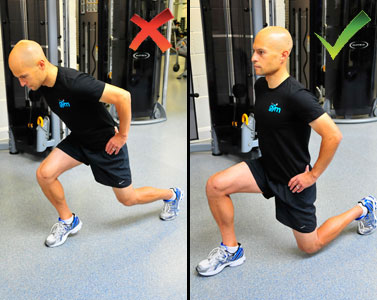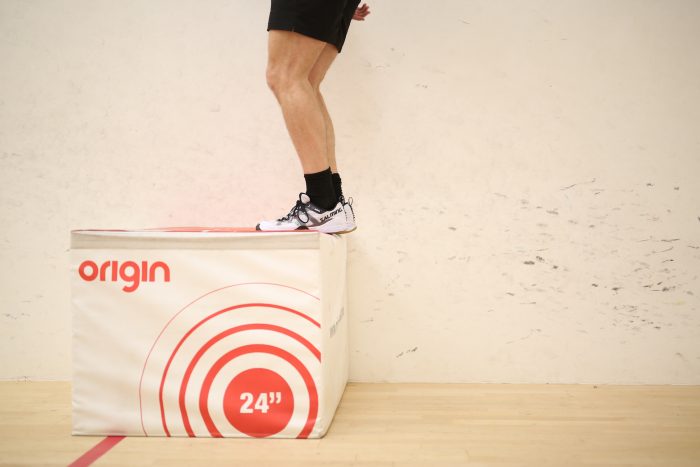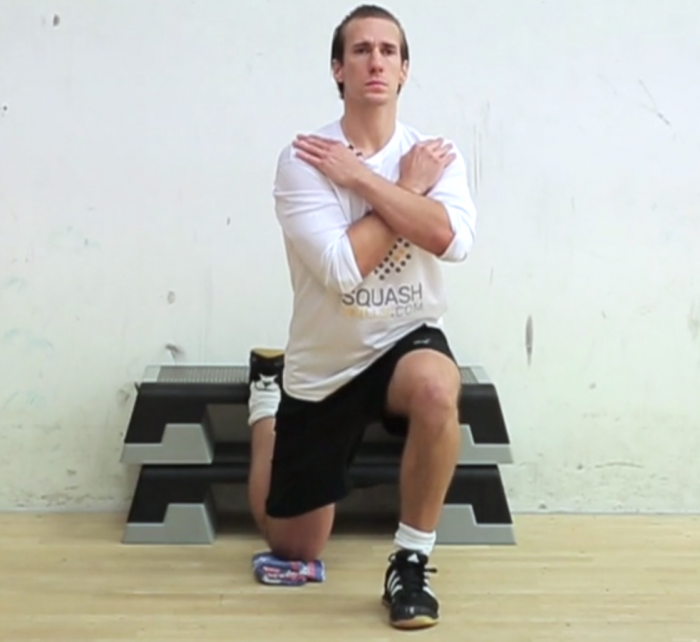Something that we speak a lot about on SquashSkills, is the importance of dedicating specific training time to developing the individual athletic qualities instead of just training your conditioning ‘generally’ – physical attributes such as Speed, Power, Strength, and Stability are vital to becoming an all-round player, and for maximising your abilities on court.
It’s great to see that there appears to be an ever-increasing awareness from many of you in our SquashSkills community of the integral part that specific physical training plays in becoming a successful player, based upon the many questions and emails we get sent. One area I think that is still too often severely neglected in many training plans however, is a focus on developing balance in both sides of the body – and this is where Unilateral Training comes in.
I worked with an elite Pakistani junior a number of years ago, who has since gone on to become a successful top 100 PSA ranked player – I still always remember when I first went through my initial assessment tests with him. One of the measurements I take when working with a new player is body part circumferences – thighs, waist, chest, arms etc. These measurements are useful to refer back to later, to measure fat loss/lean muscle gains and general growth. With this particular player, even just a brief visual check showed there were obvious large differences between his dominant and non-dominant sides – split in half, he would almost have looked like two completely different people. Upon measurement, there was a significant several inch discrepancy in the circumferences of his respective arms and legs – a massive amount, particularly in one so young.
This pattern is repeated in many athletes (generally to a slightly more subtle degree), and is usually most easily highlighted in vertical jump leg power tests – the majority of players, even at an elite level, will typically show far greater scoring on their dominant side. Of course, some small difference is to be expected, and most people will always be a little stronger on their favoured arm/leg. All too often these differences are in the region of a significant magnitude however, and being so dominant toward one side can increase injury risk, affect movement efficiency, and limit mobility on court.
The problem often comes from athletes simply not incorporating specific single limb exercises into their programmes – the aforementioned concept of ‘Unilateral Training’.
As great as double-leg compound exercises such as Squats and Deadlifts are in providing a fantastic base strength, if no additional unilateral work is incorporated into training then the dominant side of the body has a tendency to take on additional load in these double-leg movements, which will further compound the issues of a lack of balance between the opposing sides of the body.
Even in speed/power drills such as sprints, ladders, and hurdles, it is often all too apparent that an athlete is favouring their dominant side.
This is fine until they’re wrong-footed or off-balance in a game and are forced to push off with their ‘weaker’ side, resulting in a less than optimal muscular response, and a delayed movement to the ball – or worse, an overload on an unprepared area resulting in an increased risk of injury. Unilateral training ensures muscles such as the gluteus medius (in the buttocks) and quadratus lumborum (in the lower back) are engaged as stabilisers, which is critical in many sports skills – such as the lunge in squash – as well as being an integral asset to injury resistance within the body.
So what are the best unilateral exercises to incorporate?
I would suggest those new to single-leg training, follow a 3 point progression of these exercises into their programme (for more detailed guidance check out the technique videos on the fitness wall, more are being added all the time):
 Exercise Level 1 – Lunge
Exercise Level 1 – Lunge
The Lunge is an exercise that many squash players of all levels already incorporate into their training, and it should be a staple part of any resistance training programme geared toward developing single-leg strength. If done correctly, the Lunge incorporates elements of acceleration and deceleration and is also great for enhancing hip stability and flexibility.
Lunge Technique
- Start standing upright, feet together
- Step out to a comfortable distance of around 1.5 metres, keeping the torso upright and the core held tight
- Pause briefly, with the front knee joint held at approximately 90 degrees
- Push back to the start position by simultaneously driving through both the thigh (quads) AND the buttocks (gluteals)
- Ensure the buttocks and hip of the rear leg engage on the return, to aid the efficiency and stability of the movement
- Repeat on the opposite leg
- Additional resistance can be added with dumbbells held at the side, or with a barbell on the shoulders

Exercise Level 2 – Step-Up
The Step-Up is an under-utilised exercise but can be a great addition to a single leg training programme if performed correctly. By using a high enough box so that the knee joint is at 90 degrees or very slightly beyond when the lead foot is placed, the contribution of the hamstrings and gluteals is increased and it minimises the ability to ‘cheat’ by over-using the foot placed on the ground. Be aware that some people with knee or back problems may struggle with this exercise, so pay attention to your body.
Step-Up Technique
- Start standing in front of a box around knee height or slightly below, with feet together
- Step-Up with lead foot onto the box, making sure the whole foot is on the platform
- Push down through the lead foot heel and mid-foot, avoiding shifting the weight too far towards the ball of the foot
- Keeping the head and chest up, drive through the front leg to bring yourself up to full height on the box
- Avoid letting the back leg rest on the box at the peak of the movement – keep the weight on the lead/working leg, and just touch the bench lightly with the rear foot
- Step back down to the starting position, and repeat on the opposite leg
- Additional resistance can be added with dumbbells held at the side, or with a barbell on the shoulders
 Exercise Level 3 – Rear Foot Elevated Split Squat
Exercise Level 3 – Rear Foot Elevated Split Squat
Perhaps my favourite unilateral lower body exercise is the Rear Foot Elevated Split Squat (RESS). Looking at first glance like a standard split squat or static lunge, the difficulty of this exercise is increased by the elevation of the rear leg, placing a greater additional load on the lead working leg and increasing the stretch on the hip flexor muscles of the rear leg. Very few exercises hit the quads and glutes as well as the RESS, and it is a great addition to any squash player’s training programme. Do be aware however that it is of higher difficulty and places greater stress on the joints than many other exercises – don’t attempt the RESS until you can comfortably perform the Lunge and Step-Up exercises for multiple reps with the additional load.
Rear Foot Elevated Split Squat Technique
- Start standing with a low bench behind the legs
- Step out to a comfortable distance, around a metre or so away from the bench
- Place rear foot onto the bench, laces down
- Keeping the torso upright and the core held tight, smoothly lower down so that the knee of the rear (elevated) leg dips to an inch or two off of the floor (or as low as you comfortably can)
- Pause briefly, with the front knee joint held at approximately 90 degrees and not tracking too far beyond the toes
- Rise back to a fully erect position by simultaneously driving through both the thigh (quads) AND the buttocks (gluteals) of the lead leg
- Ensure the rear leg engages during the return movement, to aid the efficiency and stability of the movement
- Repeat on the same leg for prescribed reps
- Additional resistance can be added with dumbbells held at the side, or with a barbell on the shoulders
Start all of these exercises just with your own body weight as resistance, if you are new to them. Work with 2 sets of 10-12 repetitions on each leg twice a week, or incorporate into your existing resistance training programme. Also be sure to concentrate on using your ‘weaker’ leg equally in alternate sets of ghosting, ladder, and other on court drills to ensure that you are evenly balanced and able to push, accelerate, stabilise, and lunge comfortably on either side of the body in the heat of a hectic match.
Gary Nisbet
B.Sc.(Hons), CSCS, NSCA-CPT, Dip. FTST
SquashSkills Fitness & Performance Director
Sign up to the SquashSkills newsletter
Get world class coaching tips, straight to your inbox!